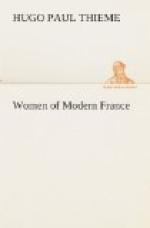Later in the century, the very opposite type prevailed; the aspiration then became to leave an emotion ungratified rather than to seduce; a languishing expression was cultivated; women sought to sweeten the physiognomy, to make it tender and mild. The style of beauty changed from the brunette with brown eyes—so much in vogue under Louis XV., to the blonde with blue eyes under Louis XVI. Even the red which formerly “dishonored France,” became a favorite. To obtain the much admired pale complexion, women had themselves bled; their dress corresponded to their complexion, light materials and pure white being much affected.
In these three stages of the development of beauty, fashion changed to harmonize with the popular style in beauty. In general, styles were influenced by an important event of the day: thus, when Marie Leczinska, introduced the fad of quadrilles, there were invented ribbons called “quadrille of the queen”; and many other fads originated in the same way. French taste and fashions travelled over entire Europe; all Europe was a la francaise, yoked and laced in French styles, French in art, taste, industry. The domination of the French Galerie des Modes was due to the inventive minds of French women in relation to everything pertaining to headdress, to detailed and delicate arrangements of every phase of ornamentation.
Every country had, in Paris, its agents who eagerly waited for the appearance of the famous doll of the Rue Saint-Honore; this figure was an exponent of the latest fashions and inventions, and, changing continually, was watched and copied by all Europe. Alterations in style frequently originated at the supper of a mistress, in the box of a dancer or in the atelier of a fine modiste; therefore, in that respect, that century differed little from the present one. Trade depended largely upon foreign patronage. Fortunes were made by the modistes, who were the great artists of the day and who set the fashion; but the hairdresser and shoemaker, also, were artists, as was seen, at least in name, and were as impertinent as prosperous.
An interesting illustration of the change of fashion is the following anecdote: In 1714, at a supper of the king, at Versailles, two English women wore low headdress, causing a scandal which came near costing them their dismissal. The king happened to mention that if French women were reasonable, they would not dress otherwise. The word was spread, and the next day, at the king’s mass the ladies all wore their hair like the English women, regardless of the laughter of the women who, being absent the previous evening, had their hair dressed high. The compliment of the king as he was leaving mass, to the ladies with the low headdress, caused a complete change in the mode.




